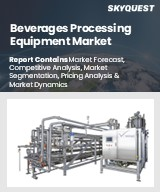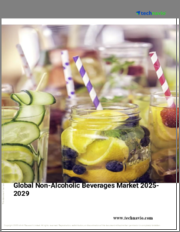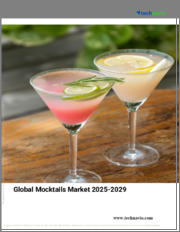
|
시장보고서
상품코드
1822429
세계의 무알코올 음료 시장 : 예측 - 제품별, 유통 채널별, 최종 사용자별, 지역별 분석(-2032년)Non-Alcoholic Beverages Market Forecasts to 2032 - Global Analysis By Product, Distribution Channel, End User and By Geography |
||||||
Stratistics MRC에 따르면 세계의 무알코올 음료 시장은 2025년에 1조 4,648억 달러로 추정되고, 예측 기간 동안 CAGR 9.4%로 성장할 전망이며, 2032년에는 2조 7,472억 달러에 이를 전망입니다.
무알코올 음료는 알코올 도수 0.5% 미만의 음료입니다. 무알코올 음료에는 청량 음료, 과일 주스, 병 식수, 차, 커피, 에너지 음료, 비타민 및 프로바이오틱스를 강화한 기능성 음료 등 다양한 제품이 포함됩니다. 이 음료는 모든 연령대와 라이프 스타일에 해당하며 수분 공급, 영양 보충, 리프레쉬 또는 취하게 하는 일 없이 에너지를 공급합니다. 건강 의식 증가, 소비자 취향의 변화, 라이프 스타일의 동향은 무알코올 음료의 세계적 수요를 견인하고 식음료 업계의 중요한 부문이 되었습니다.
건강 및 웰니스 동향
비타민 음료 및 허브 블렌드와 같은 기능성 음료가 주류가 되고 있습니다. 생산자는 깨끗한 라벨의 원료 및 투명한 조달에 중점을 둡니다. 소매업체는 저칼로리 및 영양가 높은 선택지의 선반 공간을 확장하고 있습니다. 피트니스와 라이프 스타일의 동향이 제품 개발을 형성하고 있습니다. 건강 지향 옵션은 무알코올 음료의 전망을 재정의하고 있습니다.
사회적 스티그마 및 동조 압력
소비자는 이러한 제품을 제한적이거나 덜 유명한 것으로 인식할 수 있습니다. 리브랜딩의 노력은 라이프스타일에 대한 소구와 기회와의 연관성에 초점을 맞추었습니다. 프리미엄 디자인과 타겟 메시지는 이 카테고리의 위치를 변경하는 데 도움이 됩니다. 문화적 규범과 집단 행동은 구매 결정에 계속 영향을 미칩니다. 이러한 과제는 성인 사회적 맥락에서 광범위한 침투를 제한합니다.
편의성 및 외출처에서의 소비
컴팩트한 포장과 재봉 가능한 형식이 사용 편의성을 높입니다. 유통은 교통기관 역과 피트니스 센터와 같은 거리가 많은 지역으로 확장됩니다. 제형은 에너지, 수분 공급, 정신의 명료성을 지원하기 위해 진화하고 있습니다. 온라인 채널은 맞춤형 배송 및 브랜드 참여를 가능하게 합니다. 편의성이 음료 혁신의 중심 가치 제안이 되고 있습니다.
규제 문제 및 시장 진입 장벽
성분 제한 및 표시 규칙은 시장에 따라 다르며 제품 전개를 복잡하게 만듭니다. 소규모 브랜드는 시험, 승인, 유통 장애물에 직면합니다. 정책이 세분화됨에 따라 비용이 부담되고 시장 진입이 지연됩니다. 대기업은 법적 틀을 활용하는 데 우위를 둡니다. 규제 압력은 경쟁 역학을 형성하고 신제품 진입을 늦추고 있습니다.
COVID-19의 영향 :
COVID-19는 공급망 중단, 소비 장소 이동, 건강 의식 증가를 통해 무알코올 음료 시장을 혼란시켰습니다. 가정에서 수요가 급증하면서 외식 채널과 접객 채널은 일시적으로 감소했습니다. 생산자는 면역력을 높이고, 저장이 잘 되며, 위생적으로 포장된 형태를 선호함으로써 적응했습니다. 이동이 제한되는 동안 전자상거래와 소비자 직접 판매 모델이 지지를 얻었습니다. 기능성 음료 및 웰니스 음료의 혁신은 회복기에 가속화되었습니다.
병입 음료수 부문은 예측 기간 동안 최대가 될 전망
병입 음료수 부문은 보편적인 매력, 휴대성 및 건강 지향 라이프 스타일과의 무결성으로 인해 예측 기간 동안 가장 큰 시장 점유율을 차지할 것으로 예측됩니다. 수요는 소매 및 시설 채널에서 스틸, 스파클링, 맛, 미네랄의 각 형태에 걸쳐 있습니다. 제조업체 각사는 환경에 배려한 패키징 및 수분 보급 프로파일의 강화로 기술 혁신을 진행하고 있습니다. 유통망은 편의점, 스포츠 체육관, 여행 거점으로 확대되고 있습니다. 수분 공급과 설탕 섭취량 감소를 추진하는 정부 캠페인은 병입 음료수 소비를 강화하고 있습니다.
예측 기간 동안 건강 지향적인 개인 부문이 가장 높은 CAGR을 나타낼 것으로 예측됩니다.
예측 기간 동안 기능성, 저칼로리, 영양 강화 음료에 대한 수요가 증가함에 따라 건강 지향 개인 분야가 가장 높은 성장률을 보일 것으로 예측됩니다. 소비자는 면역력, 소화력, 에너지, 정신의 명료성을 지원하는 음료를 적극적으로 요구하고 있습니다. 각 브랜드는 어댑토제닉 블렌드, 비타민 음료수, 식물 유래의 처방으로 대응하고 있습니다. 클린 라벨의 표시와 영양의 투명성에 대한 규제 당국의 지원이 신뢰를 강화하고 있습니다. 디지털 플랫폼은 개인화된 추천 및 웰니스 추적을 가능하게 합니다.
최대 점유율을 차지하는 지역 :
예측 기간 동안 북미는 에너지 음료, 풍미 워터, 프로바이오틱 음료 등 저 탄수화물, 천연 및 기능성 음료에 대한 소비자의 강한 선호로 인해 최대 시장 점유율을 차지할 것으로 예측됩니다. 건강 의식이 높은 밀레니얼 세대와 Z 세대는 깨끗한 라벨 및 지속 가능한 패키지로의 동향을 견인하고 있습니다. 미국과 캐나다는 시장을 독점하고 있으며 광범위한 소매 유통과 적극적인 마케팅 캠페인에 지원됩니다. 풍미, 영양 강화, 레디 투 음료 옵션의 혁신은 소비자를 끌어 들이고 있으며, 지역 전체에서 꾸준한 시장 성장을 유지하고 있습니다.
CAGR이 가장 높은 지역 :
예측 기간 동안 아시아태평양은 가장 높은 CAGR을 나타낼 것으로 예측됩니다. 이것은 건강 의식 증가 및 강화 주스, RTD 티, 식물성 음료 등 기능성 음료에 대한 수요 증가가 배경에 있습니다. 도시 인구의 확대, 라이프 스타일의 변화, 가처분 소득 증가가 소비를 촉진하고 있습니다. 중국, 인도, 일본 등의 국가에서는 프리미엄 음료와 유기농 음료의 채용이 급증하고 있습니다. 전자상거래와 현대적인 소매 채널은 시장 침투를 더욱 가속화하고 이 지역을 혁신과 신제품 출시의 핫스팟으로 만들고 있습니다.
무료 주문을 받아서 만드는 서비스 :
이 보고서를 구독하는 고객은 다음 무료 맞춤설정 옵션 중 하나를 사용할 수 있습니다.
- 기업 프로파일
- 추가 시장 기업의 종합적 프로파일링(3개사까지)
- 주요 기업의 SWOT 분석(3개사까지)
- 지역 세분화
- 고객의 관심에 응한 주요국 시장 추계, 예측 및 CAGR(주 : 타당성 확인에 따름)
- 경쟁 벤치마킹
- 제품 포트폴리오, 지리적 존재, 전략적 제휴에 기반한 주요 기업 벤치마킹
목차
제1장 주요 요약
제2장 서문
- 개요
- 이해관계자
- 조사 범위
- 조사 방법
- 데이터 마이닝
- 데이터 분석
- 데이터 검증
- 조사 접근
- 조사 자료
- 1차 조사 자료
- 2차 조사 정보원
- 전제조건
제3장 시장 동향 분석
- 성장 촉진요인
- 성장 억제요인
- 기회
- 위협
- 제품 분석
- 최종 사용자 분석
- 신흥 시장
- COVID-19의 영향
제4장 Porter's Five Forces 분석
- 공급기업의 협상력
- 구매자의 협상력
- 대체품의 위협
- 신규 참가업체의 위협
- 경쟁 기업간 경쟁 관계
제5장 세계의 무알코올 음료 시장 : 제품별
- 탄산 음료
- 병입 물
- 과일 주스 및 넥터
- 기능성 음료
- RTD(레디 투 드링크) 차 및 커피
- 유제품 및 유제품 대체품
- 무알코올 맥주 및 와인
- 믹서 및 시럽
- 기타 제품
제6장 세계의 무알코올 음료 시장 : 유통 채널별
- 소매점
- 온라인 플랫폼
- 푸드 서비스 및 접객 아울렛
- 음료 자동판매기
- 기관 투자가를 위한 판매
제7장 세계의 무알코올 음료 시장 : 최종 사용자별
- 일반 소비자
- 피트니스 애호가 및 선수
- 건강 지향인
- 어린이 및 10대
- 임산부
- 수석
- 전문
- 사교회 및 이벤트
- 웰니스 리트리트 및 스파
- 종교 및 문화 커뮤니티
- 접객 및 케이터링 업계
- 기타 최종 사용자
제8장 세계의 무알코올 음료 시장 : 지역별
- 북미
- 미국
- 캐나다
- 멕시코
- 유럽
- 독일
- 영국
- 이탈리아
- 프랑스
- 스페인
- 기타 유럽
- 아시아태평양
- 일본
- 중국
- 인도
- 호주
- 뉴질랜드
- 한국
- 기타 아시아태평양
- 남미
- 아르헨티나
- 브라질
- 칠레
- 기타 남미
- 중동 및 아프리카
- 사우디아라비아
- 아랍에미리트(UAE)
- 카타르
- 남아프리카
- 기타 중동 및 아프리카
제9장 주요 발전
- 계약, 파트너십, 협업 및 합작투자
- 인수 및 합병
- 신제품 발매
- 사업 확대
- 기타 주요 전략
제10장 기업 프로파일링
- The Coca-Cola Company
- PepsiCo, Inc.
- Nestle SA
- Danone SA
- Keurig Dr Pepper Inc.
- Suntory Holdings Limited
- Unilever PLC
- Red Bull GmbH
- Monster Beverage Corporation
- The Kraft Heinz Company
- National Beverage Corp.
- Nongfu Spring Co., Ltd.
- Tata Consumer Products Limited
- Parle Agro Pvt. Ltd.
- Cott Corporation
According to Stratistics MRC, the Global Non-Alcoholic Beverages Market is accounted for $1464.8 billion in 2025 and is expected to reach $2747.2 billion by 2032 growing at a CAGR of 9.4% during the forecast period. Non-alcoholic beverages are drinks specifically formulated and consumed without the presence of significant alcohol content, typically less than 0.5% by volume. They encompass a wide variety of products, including soft drinks, fruit juices, bottled water, tea, coffee, energy drinks, and functional beverages enriched with vitamins or probiotics. These drinks cater to all age groups and lifestyles, offering hydration, nutrition, refreshment, or energy without intoxicating effects. Increasing health awareness, changing consumer preferences, and lifestyle trends have driven the global demand for non-alcoholic beverages, making them a vital segment of the food and beverage industry.
Market Dynamics:
Driver:
Health and wellness trends
Functional formats like vitamin-infused water and herbal blends are becoming mainstream. Producers are emphasizing clean-label ingredients and transparent sourcing. Retailers are expanding shelf space for low-calorie and nutrient-rich options. Fitness and lifestyle trends are shaping product development. Health-focused choices are redefining the non-alcoholic beverage landscape.
Restraint:
Social stigma and peer pressure
Consumers may perceive these products as restrictive or less celebratory. Rebranding efforts are focusing on lifestyle appeal and occasion relevance. Premium design and targeted messaging are helping reposition the category. Cultural norms and group behavior continue to influence purchasing decisions. These challenges are limiting broader uptake in adult social contexts.
Opportunity:
Convenience and on-the-go consumption
Compact packaging and resealable formats are enhancing usability. Distribution is expanding into high-traffic zones like transit stations and fitness centers. Formulations are evolving to support energy, hydration, and mental clarity. Online channels are enabling customized delivery and brand engagement. Convenience is becoming a central value proposition in beverage innovation.
Threat:
Regulatory challenges and market entry barriers
Ingredient limitations and labeling rules differ across markets, complicating product rollout. Smaller brands face hurdles in testing, approval, and distribution. Fragmented policies increase cost and delay market access. Larger firms hold advantages in navigating legal frameworks. Regulatory pressure is shaping competitive dynamics and slowing new product entry.
Covid-19 Impact:
Covid-19 disrupted the non-alcoholic beverages market through supply chain interruptions, shifts in consumption venues, and heightened health awareness. In-home demand surged while foodservice and hospitality channels declined temporarily. Producers adapted by prioritizing immunity-boosting, shelf-stable, and hygienically packaged formats. E-commerce and direct-to-consumer models gained traction amid mobility restrictions. Innovation in functional and wellness beverages accelerated during recovery.
The bottled water segment is expected to be the largest during the forecast period
The bottled water segment is expected to account for the largest market share during the forecast period due to its universal appeal, portability, and alignment with health-conscious lifestyles. Demand spans still, sparkling, flavoured, and mineral formats across retail and institutional channels. Producers are innovating with eco-friendly packaging and enhanced hydration profiles. Distribution networks are expanding into convenience stores, gyms, and travel hubs. Government campaigns promoting hydration and reduced sugar intake are reinforcing bottled water consumption.
The health-conscious individual segment is expected to have the highest CAGR during the forecast period
Over the forecast period, the health-conscious individual segment is predicted to witness the highest growth rate due to rising demand for functional, low-calorie, and nutrient-enhanced beverages. Consumers are actively seeking drinks that support immunity, digestion, energy, and mental clarity. Brands are responding with adaptogenic blends, vitamin-infused waters, and plant-based formulations. Regulatory support for clean-label claims and nutritional transparency is reinforcing trust. Digital platforms are enabling personalized recommendations and wellness tracking.
Region with largest share:
During the forecast period, the North America region is expected to hold the largest market share by strong consumer preference for low-sugar, natural, and functional drinks, including energy beverages, flavoured waters, and probiotic drinks. Health-conscious millennials and Gen Z are driving trends toward clean-label and sustainable packaging. The U.S. and Canada dominate the market, supported by widespread retail distribution and active marketing campaigns. Innovation in flavors, fortification, and ready-to-drink options continues to attract consumers, sustaining steady market growth across the region.
Region with highest CAGR:
Over the forecast period, the Asia Pacific region is anticipated to exhibit the highest CAGR, driven by rising health awareness and increasing demand for functional drinks such as fortified juices, RTD teas, and plant-based beverages. Expanding urban populations, changing lifestyles, and higher disposable incomes are fuelling consumption. Countries like China, India, and Japan are witnessing a surge in premium and organic beverage adoption. E-commerce and modern retail channels are further accelerating market penetration, making the region a hotspot for innovation and new product launches.
Key players in the market
Some of the key players in Non-Alcoholic Beverages Market include The Coca-Cola Company, PepsiCo, Inc., Nestle S.A., Danone S.A., Keurig Dr Pepper Inc., Suntory Holdings Limited, Unilever PLC, Red Bull GmbH, Monster Beverage Corporation, The Kraft Heinz Company, National Beverage Corp., Nongfu Spring Co., Ltd., Tata Consumer Products Limited, Parle Agro Pvt. Ltd. and Cott Corporation.
Key Developments:
In June 2025, Suntory expanded its Natural Water Sanctuary Initiative globally, collaborating with local governments and NGOs to enhance water source recharge and biodiversity. This aligns with its "Water Positive" commitment to replenish more than 100% of water used in beverage production.
In February 2025, Keurig Dr Pepper completed the acquisition of GHOST Energy, expanding its functional beverage portfolio. The deal supports entry into the high-growth energy drink segment and complements KDP's strategy to diversify beyond traditional carbonated soft drinks.
Products Covered:
- Carbonated Soft Drinks
- Bottled Water
- Fruit Juices & Nectars
- Functional Beverages
- Ready-to-Drink (RTD) Tea & Coffee
- Dairy & Dairy Alternatives
- Non-Alcoholic Beers & Wines
- Mixers & Syrups
- Other Products
Distribution Channels Covered:
- Retail Stores
- Online Platforms
- Foodservice & Hospitality Outlets
- Beverage Vending Machines
- Institutional Sales
End Users Covered:
- General Consumers
- Fitness Enthusiasts & Athletes
- Health-Conscious Individuals
- Children & Teens
- Pregnant Women
- Seniors
- Professionals
- Social Gatherings & Events
- Wellness Retreats & Spas
- Religious & Cultural Communities
- Hospitality & Catering Industry
- Other End Users
Regions Covered:
- North America
- US
- Canada
- Mexico
- Europe
- Germany
- UK
- Italy
- France
- Spain
- Rest of Europe
- Asia Pacific
- Japan
- China
- India
- Australia
- New Zealand
- South Korea
- Rest of Asia Pacific
- South America
- Argentina
- Brazil
- Chile
- Rest of South America
- Middle East & Africa
- Saudi Arabia
- UAE
- Qatar
- South Africa
- Rest of Middle East & Africa
What our report offers:
- Market share assessments for the regional and country-level segments
- Strategic recommendations for the new entrants
- Covers Market data for the years 2024, 2025, 2026, 2028, and 2032
- Market Trends (Drivers, Constraints, Opportunities, Threats, Challenges, Investment Opportunities, and recommendations)
- Strategic recommendations in key business segments based on the market estimations
- Competitive landscaping mapping the key common trends
- Company profiling with detailed strategies, financials, and recent developments
- Supply chain trends mapping the latest technological advancements
Free Customization Offerings:
All the customers of this report will be entitled to receive one of the following free customization options:
- Company Profiling
- Comprehensive profiling of additional market players (up to 3)
- SWOT Analysis of key players (up to 3)
- Regional Segmentation
- Market estimations, Forecasts and CAGR of any prominent country as per the client's interest (Note: Depends on feasibility check)
- Competitive Benchmarking
- Benchmarking of key players based on product portfolio, geographical presence, and strategic alliances
Table of Contents
1 Executive Summary
2 Preface
- 2.1 Abstract
- 2.2 Stake Holders
- 2.3 Research Scope
- 2.4 Research Methodology
- 2.4.1 Data Mining
- 2.4.2 Data Analysis
- 2.4.3 Data Validation
- 2.4.4 Research Approach
- 2.5 Research Sources
- 2.5.1 Primary Research Sources
- 2.5.2 Secondary Research Sources
- 2.5.3 Assumptions
3 Market Trend Analysis
- 3.1 Introduction
- 3.2 Drivers
- 3.3 Restraints
- 3.4 Opportunities
- 3.5 Threats
- 3.6 Product Analysis
- 3.7 End User Analysis
- 3.8 Emerging Markets
- 3.9 Impact of Covid-19
4 Porters Five Force Analysis
- 4.1 Bargaining power of suppliers
- 4.2 Bargaining power of buyers
- 4.3 Threat of substitutes
- 4.4 Threat of new entrants
- 4.5 Competitive rivalry
5 Global Non-Alcoholic Beverages Market, By Product
- 5.1 Introduction
- 5.2 Carbonated Soft Drinks
- 5.3 Bottled Water
- 5.4 Fruit Juices & Nectars
- 5.5 Functional Beverages
- 5.6 Ready-to-Drink (RTD) Tea & Coffee
- 5.7 Dairy & Dairy Alternatives
- 5.8 Non-Alcoholic Beers & Wines
- 5.9 Mixers & Syrups
- 5.10 Other Products
6 Global Non-Alcoholic Beverages Market, By Distribution Channel
- 6.1 Introduction
- 6.2 Retail Stores
- 6.3 Online Platforms
- 6.4 Foodservice & Hospitality Outlets
- 6.5 Beverage Vending Machines
- 6.6 Institutional Sales
7 Global Non-Alcoholic Beverages Market, By End User
- 7.1 Introduction
- 7.2 General Consumers
- 7.3 Fitness Enthusiasts & Athletes
- 7.4 Health-Conscious Individuals
- 7.5 Children & Teens
- 7.6 Pregnant Women
- 7.7 Seniors
- 7.7 Professionals
- 7.8 Social Gatherings & Events
- 7.9 Wellness Retreats & Spas
- 7.10 Religious & Cultural Communities
- 7.11 Hospitality & Catering Industry
- 7.12 Other End Users
8 Global Non-Alcoholic Beverages Market, By Geography
- 8.1 Introduction
- 8.2 North America
- 8.2.1 US
- 8.2.2 Canada
- 8.2.3 Mexico
- 8.3 Europe
- 8.3.1 Germany
- 8.3.2 UK
- 8.3.3 Italy
- 8.3.4 France
- 8.3.5 Spain
- 8.3.6 Rest of Europe
- 8.4 Asia Pacific
- 8.4.1 Japan
- 8.4.2 China
- 8.4.3 India
- 8.4.4 Australia
- 8.4.5 New Zealand
- 8.4.6 South Korea
- 8.4.7 Rest of Asia Pacific
- 8.5 South America
- 8.5.1 Argentina
- 8.5.2 Brazil
- 8.5.3 Chile
- 8.5.4 Rest of South America
- 8.6 Middle East & Africa
- 8.6.1 Saudi Arabia
- 8.6.2 UAE
- 8.6.3 Qatar
- 8.6.4 South Africa
- 8.6.5 Rest of Middle East & Africa
9 Key Developments
- 9.1 Agreements, Partnerships, Collaborations and Joint Ventures
- 9.2 Acquisitions & Mergers
- 9.3 New Product Launch
- 9.4 Expansions
- 9.5 Other Key Strategies
10 Company Profiling
- 10.1 The Coca-Cola Company
- 10.2 PepsiCo, Inc.
- 10.3 Nestle S.A.
- 10.4 Danone S.A.
- 10.5 Keurig Dr Pepper Inc.
- 10.6 Suntory Holdings Limited
- 10.7 Unilever PLC
- 10.8 Red Bull GmbH
- 10.9 Monster Beverage Corporation
- 10.10 The Kraft Heinz Company
- 10.11 National Beverage Corp.
- 10.12 Nongfu Spring Co., Ltd.
- 10.13 Tata Consumer Products Limited
- 10.14 Parle Agro Pvt. Ltd.
- 10.15 Cott Corporation



















